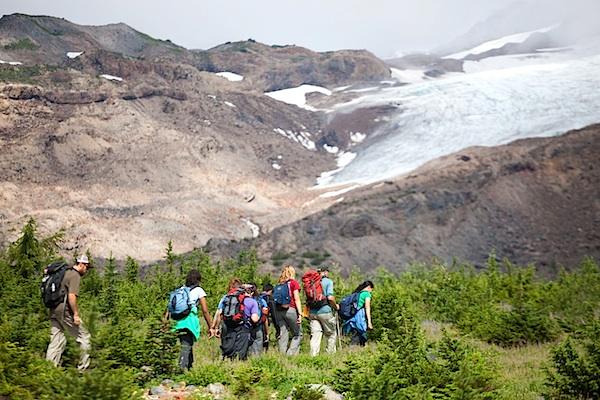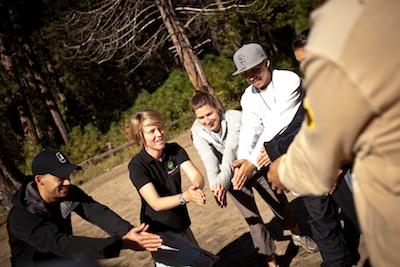
Getting up close to glaciers is part of the North Cascades Institute's Youth Leadership Adventures / Ethan Welty.
Climate change. Glaciology. Sustainability.
These are not the subjects that leap to mind when you consider sending your kids to summer camp. But blend them with backpacking, canoeing, or a walk in the woods, and the result is a generation with not only a better connection with nature, but perhaps a career path.
Such blending occurs at places such as the North Cascades Institute, the Great Smoky Mountains Institute at Tremont, NatureBridge, the Yellowstone Association Institute, the Grand Canyon Field Institute, and other field schools that work in national park settings.
These nonprofit organizations offer programs that last anywhere from a day or two to a week or two, or even more, and in some of the grandest natural settings in the world: Yosemite National Park's iconic valley, the Inner Gorge of Grand Canyon National Park, the glaciated roof of North Cascades National Park, the tangle of forests in Great Smoky Mountains National Park, and North America's Serengeti, the northern sweep of Yellowstone National Park.
These settings seem to resonate with students', teachers', and adults' innate thirst for nature. Saul Weisberg, who helped found the North Cascades Institute in 1986, has seen students from every walk of life positively affected by their experiences in North Cascades National Park and other public lands that the Institute uses as outdoor classrooms.
'Some of the kids who are wealthy come in with the expectation that they're going to go to college, but they're not particularly excited. And some of the poor kids are coming with the expectation that they're not going to make it to college,' said Mr. Weisberg. 'But they spend two or three weeks in the field with our graduate students, who are some of the core teachers of our programs, and they get really jazzed and they all come back really excited to do this. And they want to go on.
'¢ North Cascades Institute offers programs that range from youth leadership to Mountain School, an environmental education program that takes kids into the national park to study glaciers, geology, and climate change, as well as the cultural history of the region.
'¢ NatureBridge's programs revolve around four core areas: academics, leadership, stewardship and team building that can be customized based on a teacher's desires.
'¢ The Grand Canyon Field Institute, an arm of the Grand Canyon Association, takes more than 2,000 participants a year on trips ranging from a walk along the South Rim of Grand Canyon National Park to running the Colorado River through the park's basement.
'¢ The Great Smoky Mountains Institute at Tremont offers more than 30 programs ranging from photography and a Backcountry Ecological Expedition. This program is for teens who contribute to the All-Taxa Biodiversity Inventory in Great Smoky Mountains National Park during week-long backcountry trips to a Southern Appalachian Natural Certification program.
'¢ The Yellowstone Association Institute has a thick course book with programs as diverse as public lands stewardship, wilderness first aid, and the power of interpretive writing.
'I think the message is that it's having these multiple pathways to get engaged with public lands. We do this on park land, we do things on Forest Service (land), we do some of it on state land,' he went on. 'But the public lands piece is the real component of it. And the parks, it's obviously a real dramatic place. These kids are out canoeing on big wild lakes and backpacking, but they're doing service projects and they're learning a lot about how to reflect on where they came from and what they're learning.'
And they're providing a glimmer of hope for future generations. Perhaps the warning Richard Louv gave us with his 2005 book, Last Child in the Woods, Saving Our Children From Nature-Deficit Disorder, wasn't entirely right in that younger generations care little for nature.
'I think kids do care about nature. I think there are a lot of kids who, their world might be electronic screens, but I think when they get out in nature, they love it. And so, they want to come back and share it,' Mr. Weisberg said.
'We've been doing this work and adding these different programs for 28 years. And, it's really successful. It really is working,' he continued. 'It's providing these transformative experiences for thousands of people. We've been having pretty good success in tracking people over time. That's true, particularly with our graduate students, who are in some ways our most significant seed. We're planting out there all over the world, including people who are going on to work with careers in the Park Service and other agencies.'

NatureBridge's programs bring students into the parks, such as these settings in Yosemite National Park / NatureBridge.
Today, NatureBridge, which started offering programs as the Yosemite Institute back in 1971, works with about 30,000 students and teachers each year in places as diverse as Yosemite and Olympic national parks as well as Joshua Tree National Park and Prince William Forest Park. Attendance might have sagged bit due to the economy, but Marya Carr doesn't believe disinterest in nature has affected their programs.
'Our attendance has not gone down. We're struggling a little bit because of the economy, and California schools are very, very pinched with the economy the last few years,' said Ms. Carr, who oversees sales and marketing for Nature- Bridge's Yosemite programs. 'A lot of teachers and administrators have a hard time stomaching leaving the classroom for three days, five days, and missing out on testing time. That's put a dent in our attendance, but I don't think it's been a move away from nature.'
If anything, it's a move into nature.
'A lot of people who love national parks don't necessarily know that we exist, don't know that there's this opportunity for a classroom of kids, or any other kind of youth group,' said Ms. Carr. 'Any kind of group can do a program with us. There are so many people who love national parks or love Yosemite specifically or love Olympic specifically who may not know that that's a possibility.'
It's definitely summer camp, but with a unique educational twist.



Add comment